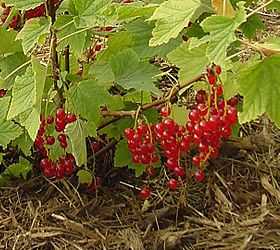How to Grow Redcurrants – A Guide to Growing Redcurrants
 Redcurrants
Redcurrants
Redcurrants are in many ways grown in the same way as gooseberries rather than like blackcurrants. They can be grown as bush , espalier or vertical cordons .
Varieties of Redcurrant
- Jonkheer Van Tets is a popular variety. It produces a heavy crop early of good flavour fruit in early July . The branches can be brittle and it does best as a cordon.
- Rovada is late to flower and crop and is, therefore, good for areas of the country that may suffer with spring frosts. It has a good flavoured and produces lots of fruit in early August .
- Stanza is a small to medium sized variety . It is late flowering so reducing the chance of spring frost damage. It bears a heavy crop of small slightly acidic fruit in late July. Its compact growth makes it suitable for container growing and small gardens .
Pests and Problems with Redcurrants
- Redcurrants do not suffer from many problems. They are best grown under netting or in a fruit cage to protect them from the finches that will peck out the buds and other birds who love to eat the ripe berries.
Growing Redcurrants
- The ground should be prepared and cultivated in the same way as for blackcurrants .
- Plant bare rooted plants in winter when they are dormant. Prepare the soil in the same way as for blackcurrants but plant them to their original depth rather than lower in the soil.
- Container grown redcurrants may be planted at any time.
- Redcurrants should be pruned in the same way as gooseberries as they fruit on spurs from the main stems, on old wood and at the base of new wood.
- They can be grown as espalier or vertical cordon plants, but are often grown as bushes.
- At planting time cut back the main stems to an outward facing bud to about half their length. Cut off any shoots on the main stem that are within 10 cm (4 inches) of the ground .
- From the second winter onwards shorten the main branches by about one third, cutting just above an outward facing bud.
- Then remove any dead, crossing, inward or downward growing branches by cutting back to the first bud. This will keep the centre of the bush open and airy and allow easy harvesting. Shorten any other side shoots by half, cutting to just above an outward facing bud. Keep the centre of the bush open and airy.
Harvesting Redcurrants
- Redcurrants can crop so heavily in good years that the branches may bend or break. At times like this support the branches by tying them to stakes or canes or to wires.
- Pick the berries when they are well coloured shiny and taste sweet, if they are dull you have waited too long. The will not all ripen at the same time so pick them over 2 or 3 times. Pick the whole strig (cluster of berries) at a time rather than individual fruit.
Eating Redcurrants
- Use redcurrants at once or they may be kept in the fridge for up to a week.
- Redcurrants are rich in vitamin C but this may reduce if cooked.
- They are delicious to eat raw, or can be used use in jams and jellies. They make a delicious sauce to use with ice cream and are good used in baking and drinks .
- They freeze well and a spoonful of frozen berries can be added to breakfast cereals and porridge .



